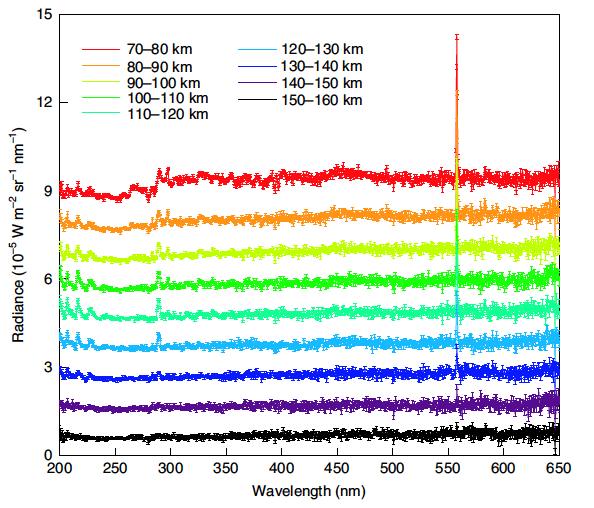Variations of the Martian oxygen green line dayglow: response to solar activity
- 1LPAP, STAR Institute, Université de Liège, Liège, Belgium.
- 2Royal Belgian Institute for Space Aeronomy, Brussels, Belgium
The presence of the Martian oxygen green line emission at 557.7 nm in the Martian dayglow was discovered with the NOMAD-UVIS ultraviolet-visible spectrometer on board ESA’s Trace Gas Orbiter (Gérard et al., 2020). It corresponds to the 1S -1D forbidden transition in the O atom. Limb profiles of the emission have been observed with a vertical resolution of about 10 km. They generally show two peaks near 80 km and 110 km during quiet solar periods. Intensity and altitude variations of the emission peaks have been previously reported (Soret et al., 2022). The green line is by far the strongest feature in the Mars dayglow spectrum.

Fig. 1: NOMAD/UVIS dayside limb spectra binned into altitudes regions between 70 and 160 km. In addition to the strong green line, the OI line at 297.2 nm and the CO2+ UV doublet at 288-289 nm are also observed. The spectral resolution varies from 1.2 nm at 200 nm to 1.6 nm at 600 nm (Gérard et al., 2020)
The O(1S) level is mainly excited by photodissociation of CO2 by solar EUV radiation, with minor contributions mostly from electron impact on CO2 molecules and dissociative recombination of CO2+ ions. The doublet at 630-636.4 nm has also been observed but is about 20 times weaker (Gérard et al., 2021; Soret et al., 2022). The lower peak is excited by solar Lyman-a radiation while the upper one is produced by a range of EUV radiation.
Dayside observations have been performed since April 2019 and monitored to observe the changing brightness and peak altitude as solar activity increases. Observations of the UV counterpart 1S-3P at 297.2 nm of the green line have shown that the upper emission peak remains located at a pressure level close to 0.39 microbar (Gkouvelis et al., 2018). The solar EUV flux at the Mars location is provided in three spectral channels by the EUV monitor (EUVM) on board MAVEN. UVIS dayglow observations collected at different seasons and latitudes have shown that the 557.7-nm emission varies with season and latitude (Soret et al., 2022), making it possible to follow CO2 density variations in the mesosphere.
Fig. 2: Limb profiles of the OI 557.7-nm dayglow (c) in northern Spring and Summer, (d) in southern Spring and Summer Numerical simulations for the same conditions are shown in red (Soret et al., 2022).
In this study, we present time variations of the altitude and brightness of the green line distribution during the period of rising activity. We show that the limb brightness directly responds to the intensity of the solar Lyman-alpha flux, while the attitude shows a more complex response dependence, a signature of the expansion and contraction of the atmosphere.
REFERENCES
Gérard, J. C., Aoki, S., Willame, Y., Gkouvelis, L., Depiesse, C., Thomas, I. R., et al. (2020). Detection of green line emission in the dayside atmosphere of Mars from NOMAD-TGO observations. Nature Astronomy, 4(11), 1049–1052.
Gérard, J. C., Aoki, S., Gkouvelis, L., Soret, L., Willame, Y., Thomas, I. R., et al. (2021). First observation of the oxygen 630 nm emission in the Martian dayglow. Geophysical Research Letters, 48(8), e2020GL092334. https://doi.org/10.1029/2020GL092334.
Gkouvelis, L., Gérard, J. C., Ritter, B., Hubert, B., Schneider, N. M., & Jain, S. K. (2018). The O(1S) 297.2-nm dayglow emission: A tracer of CO2 density variations in the martian lower thermosphere. JGR Planets, 123(12), 3119–3132.
Soret, L., Gérard, J.-C., Aoki, S., Gkouvelis, L., Thomas, I. R., Ristic, B., et al. (2022). The Mars oxygen visible dayglow: A Martian year of NOMAD/UVIS observations. JGR Planets, 127, e2022JE007220.
How to cite: Gérard, J.-C., Soret, L., Robin, H., Thomas, I., Ristic, B., Vandaele, A. C., and Hubert, B.: Variations of the Martian oxygen green line dayglow: response to solar activity, Europlanet Science Congress 2024, Berlin, Germany, 8–13 Sep 2024, EPSC2024-896, https://doi.org/10.5194/epsc2024-896, 2024.